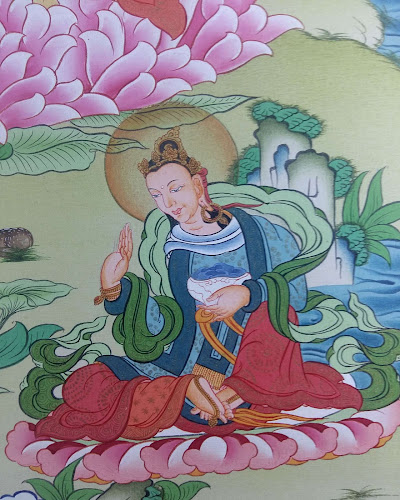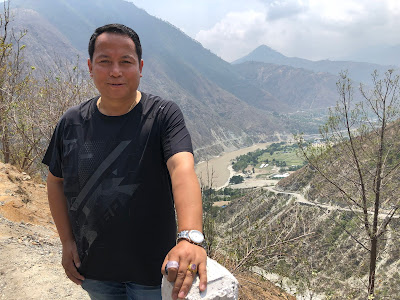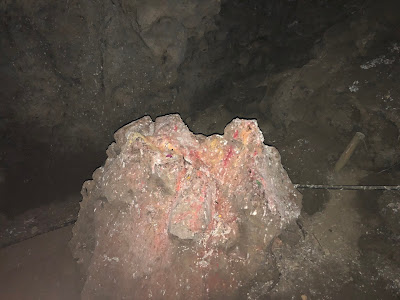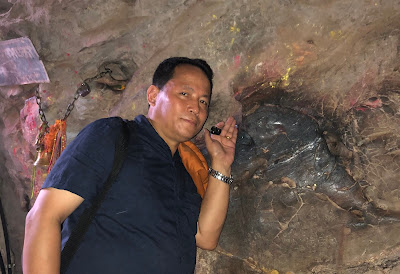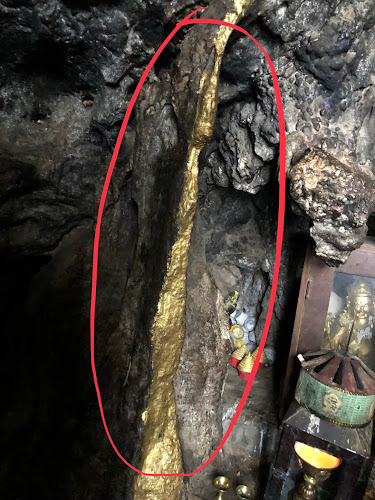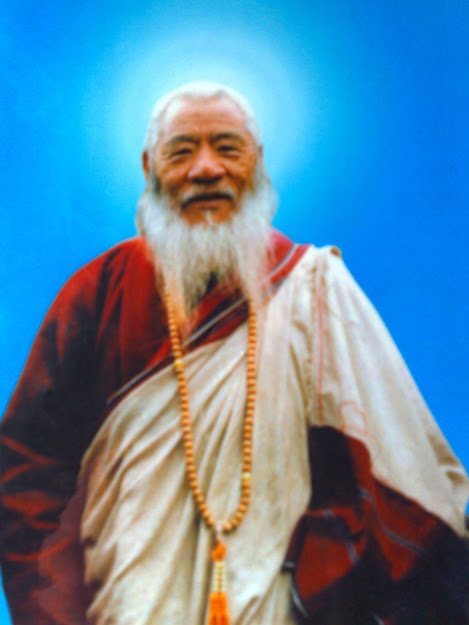After Guru Rinpoche had transformed his execution pyre into the lake we now know as Tso Pema, in modern day Himachal Pradesh, he is said to have flown to Maratika Cave in, Eastern Nepal with his consort, Princess Mandarava. Guru Rinpoche’s biography describes Draphu Maratika as a place where a “rain of flowers constantly falls. Enveloped in a dome of rainbows, the scent of incense permeates the air. It has a grove of sandalwood trees and is blessed by Lords of the Three Families”.
Maratika or ‘Chi ba mthar byed’ in Tibetan means “eliminates from death”, and is known as Halesi or “literally astonishing”.
Mandarava’s biography describes Maratika as a “sacred power spot where the outer, inner, and secret mandalas were complete... a wish fulfilling jewel that surpasses any other sacred place in India for the practice of spiritual attainment”
For Tibetan Buddhists in particular, it is the site of immortality, one of the six supreme pilgrimage sites in the world. It is the place where the great master, the second Buddha Padmasambhava (commonly known as Guru Rinpoche) and Dakini Mandarava obtained the realization of immortal life. Maratika was also blessed by the family of three protectors Manjushri, Vajrapani and Avalokitesavara.
The caves of Maratika are mentioned in Tibetan literature from the twelfth century onwards. A biography of Guru Rinpoche, discovered by Nyangrel Nyima Ozer
, describes why the Maratika caves are a sacred place for Buddhists. Other written sources say that at the request of the Bodhisattva Avalokiteshvara, Buddha Amitabha taught the eighteen tantras of Long Life. The dakinis wrote them down in their symbolic script using melted lapis lazuli on golden paper, and deposited them in a box made of five precious jewels, which they concealed in the secret Maratika cave. There are said to be many treasures buried in this holy place.Guru Rinpoche came to Maratika with his consort, the Indian Princess Mandarava, to perform the practice of vidyadhara longevity. After three months retreat at the Maratika Cave
Through this momentous connection of the Mahaguru, his consort, and their accomplishment of unending life, Maratika sets the stage for lifetimes of Guru Rinpoché’s enlightened activity throughout India, Nepal, Tibet, and countless other realms. The very landscape of Maratika has become indivisible from the mandala of Amitayus, as practiced and accomplished by Guru Rinpoché and Mandarava.It is considered to be the very residence of the Buddha of Boundless Life, Amitayus, a sacred site that still imbues pilgrims with its unique blessings. For this reason, it’s unmatched as a supreme practice location for the empowerment and extension of life and longevity.
Following this they practiced the Hayagriva Mechar Cycle on the union of Hayagriva and Vajravarahi in order to eliminate any further obstacles.
Upon successful realization, Mandarava “compiled a treasury of more than a thousand extensive and concise longevity methods, including essential pointing-out instructions”.For Buddhists, Maratika cave is most famous as a special spot for long-life practices. This is particularly true of the site of the Parbati stone, called chhepuma in Tibetan. The water that drips from the stones in several places throughout these caves, originating from the rock itself, is collected and considered to be the equivalent of the Amitayus long-life nectar. The lamas at Maratika prepare a pill with this umbrik and call it the “Maratika Long Life Pill (‘Liberation of Tasting’).”
After two days of long drive from Phuentsholing by Siliguri we entered Nepal through Panitanki, halt a night in one city and the next day towards evening we reached the great and most sacred Ney of Guru Rinpoche, the Draphu Maratika.
Immediately after check-in in one hotel near Draphu Maratika we have immediately proceeded to the main Treasury Cave with main aspiration to see and received blessing from long-life vase (tse bum) made of stone,
We were surprised to see a Tibetan Monastery called Maratika Chimey Takten Choling Monastery that stands at the mouth of the sacred cave.
Interestingly Lama Ngawang Chophel Gyatso was born in 1922 after his parents came to Maratika to ask for children. Though he lived far away, the association was natural. In 1968 he suffered from an illness for which he practiced long-life exercises in Maratika under the order of his teacher. Finally, he purchased a plot of land from Mahanta Giri family. The construction of this monastery faced severe crisis from Hindu groups which is now amicably settled. I was very happy to see Buddhist temple at the entrance of the famous cave. We went directly inside this monastery, made prostration and prayer.
With great excitement, I step in the great Maratika Cave. There was feeling of joy, happiness and blessing.
I immediately went to Amitayus long life vase and prayed for the long life of His Majesty the King and His Holiness the Je Khenpo. During that time, I was reciting 100 syllabus Vajrasattava mantra and recited 99,999 and last one recitation was done facing the Amitayus long life vase completing 100,000 recitation of Vajrasattava mantra. I than took a blessing to recite the long mantra of Amitayus.
The cave contains many self-created images and syllables (rang jung). There is self-created Amitayus image on a rock,
Naturally formed Phurba (Kilys) from the Duetsi of Long life Vase. There is rock in the shape of a box that grants all wishes; it is especially for women hoping to become pregnant. Even the sound of the bats in this cave is said to be the sound of the long-life syllable Hri. Steping further below is a huge circular hall where Hindu temples of Lord Shiva was housed.The lower cave, which is ten-minutes walk down the hillside, is the Cave of the Eight Means of Attainment.
This is where Guru Rinpoche slew a demon. Inside the entrance is the stone emanation of the flesh and blood of the demon. To the left of the entrance is a white conch shell that comes out from the rock; It is said that with hearing this sound the evil states of cyclic existence are shattered. Guru Rinpoche flew through the roof of this cave, leaving a large hole through which the sky is visible — this is called the sky door.Five hundred Arhats are said to have visited this place, and many people come here to practice Chad. I also did symbolic Jo Chod practice of Pema Dagnag Lingpa.
The greater region is made up of three hills or holy mountains, the central smaller of which is known as Avalokitesavara mountain and houses the two main caves itself. On either side of the Avalokitesavara hill stand Vajrapani hill
to the south which has no caves and Manjushri hill to the north ,making up the trio of the “family of three protectors” or Rig sums gonpo in Tibetan. There is a Garuda cave which is good place to go t for people with cancer.After receiving blessing from all the Neys we than proceeded to Manjushri Hill. Climbing further up we entered cave and received blessing from Manjushri formation. There is another Guru Rinpoche’s meditation cave.
The visit to Draphu Maratika was life experiencing visit. All those associated with Guru Rinpoche must visit this sacred place.
For further reading:
Condense Guide to Maratika by Guru Rinpoche.
Condensed guide of the great cave known as Maratika or Haleshe (Halesi) in the Nepali language, known as Bhiurda or Deshanya in the Indian language, and as Ha Las Bsdhad or astonishing in Tibetan.
At the time when he was building the glorious Samye, King Trisong Deutsen sent one of his ministers to India to invite the master Padmasambhava. On their way back, through Nepal, as they were taking a rest, the minister asked; “Guru Rinpoche, why is this mountain so astonishing?”
The master replied; “Listen faithful minister, there are Outer, Inner and Secret explanations concerning this place. The Inner and Secret cannot be told now and the Outer can be disclosed just a bit.”
Again the minister asked;
“Guru Rinpoche, for the sake of the faithful, please give a short explanation about this place.”
The Guru spoke thus; “The Inner and Secret explanations are hidden as termas, but I will talk a little about the Outer explanation.
Listen, faithful minister”.
“OM SOSTI This supreme Holy Place is similar to Ogmin and Khacho Buddha Fields.
Above; the Lamas of the Eight Means of Attainment are arranged like a mass of clouds.
In the middle dwells an assembly of rainbow-like deities.
Below; the ocean of oath-bound protectors roar like thunder.
In front; the offering goddesses perform their dance.
The first secret path on the right differentiates between virtue and sin and is the great path of the hot and cold hells.
The stone path behind shows the narrow path of the intermediate state between death and rebirth.
The path on the left is the great path purifying the defilements and obscurations of the womb and collecting the two accumulations of merit and wisdom.
The rocky path in front is the great path purifying all sins and obscuration of immoral priests and monks who have broken their commitments.
These four secret paths bring liberation from the eighteen hell realms.
At that place there are self-created images of Brahma, Indra, Hayagriva and Dorje Phagmo in union, the Naga King Taksaka (dGa’bo ‘jog po) and a box of good fortune (g.yang gi gau) that grants the birth of sons and daughters and whatever one prays for.
In the four directions are the Four Great Kings.
Above are self created umbrellas, victory banners, standards and canopies.
In the middle is a self-created prayer to the Guru written in the symbolic script of the dakinis.
Inside the cave, seven steps above, is the self-created Life Vase used by Amitayus for bestowing the Empowerment of Immortality.
There is no doubt that all the prayers addressed to it will be fulfilled.
At the right of the Life Vase is the self-created body imprint of Amitayus visible on the rock.
The entrance to this place resembles a half moon and faces towards the east, while the path leading to it comes from the south.
A large number of trees grow in that place, the birds sing melodiously and there are many sweetly scented flowers.
In front is a self-created lake, and at the distance of an arrow shoot is the self-created, Secret Cave of the Guru.
The second entrance to this holy place is known as the Meditation Cave of the Eight Means of Attainment.
Inside is the self-created stone of the flesh, blood and soul of the liberated (or liberating) female demons.
At the left of this door is a turquoise conch shell. Just by hearing it’s sound, the evil states of cyclic existence are shattered.
Five hundred Arhats are said to have visited this place.
Inside is the Guru’s blessed water. It is said that by putting that blessed water in the mouth, the five heinous negative actions are purified.
Also inside are the Guru’s footprint and the self-created, unobstructed Door of the Sky.
Above are the Guru’s toilet and his self-created thighbone trumpet and hat.
Women who have pollution, and extremists should refrain from going there as they will encounter misfortune.
In front of the first entrance to that holy place there is a lotus tree.
At the east is the peaceful Assembly Hall.
At the south is the imprint of the Guru’s body and the Assembly Hall of the Hundred Thousand Dakinis.
At the west is the Meditation Cave of Dorje Phagmo.
At the north is the self-created rock imprint of the Three Protectors.These are the signs related to pacifying, increasing, controlling and wrathful activities.
At the southeast is Manjushri Hill and Southwest Vajrapani Hill.
When visiting this great place Maratika, the highest people should engage in longevity practices, the middle ones should perform offerings, and the general practitioners should make prostrations and circumambulation.
If one visits this great holy place called Halashe or “astonishing”, one will not need to experience the lower realms.”
Thus spoke the Great Guru.
A Guide to Maritika Cave, Supreme Site of Immortality
by Chatral Sangyé Dorjé Rinpoche
Namo Guru Deva Ḍākinyai!āyus,
To emptiness itself, Great Mother Tārā, clothed in white,[2]
And to the three root long-life deities[3] in mudrā of union,
North of Bodhgaya’s Vajra Seat — hub of this world —
Listen closely now with joy, as I describe:
Outwardly, the site of Śiva and Umā's delightful play,ṃvara,ṣṭha Dharmadhātu —āvatī, realm of great bliss.
Was staying in the cave with the enchanting Lady Mandāravā,ā,āyus, Boundless Life, they received empowerment,
With their bodies they transcended all of birth, death, age, and sickness,ākṣasasṃsāra endures.
Later, from the brow of Songtsen Gampo — Avalokiteśvara in person —ṣu Akarma.
On his quest, he miraculously reached the cave of Māratika,
Naming it the “Practice Cave, Maṇḍala of Splendid Qualities,”
This event alone is proof of Māratika’s greatness.īrthika known as Śaṅkara Ācārya
His followers claiming them as sites of Śiva.
Today people make pūjās and offerings of tridents,
Neither blood offerings nor animal sacrifice ever happen here.
From dawn to dusk they sound all kinds of drums, cymbals, conches —ā, Viṣṇu, Mahādev and the rest.
They discriminate by caste, from brahmin down to śūdra,
Adhering still to their ancient traditions,
When the brahmins are in the cave, performing their pūjāsṇḍalas
And so, since all beings have their individual perspectives,
To foster inspiration at the very outset,āratika.
Let all doubts regarding this place be herewith dispelled
E ma! Having touched on just a few of the qualities of this place,
As is said in the commentaries — and for good reason —
Merely bringing it to mind dispels the danger of untimely death.
The broad sky is vast, like an eight-spoked wheel;
The sun and moon reach everywhere,
A self-arisen hall at its centre —
Myriad trees and vegetation grow from solid rock.ās,
In particular, this great holy site is studded with stone liṅgas.
Naturally arisen, glowing, white and smooth, they glisten.ṛta drip down.
The cave has many entrances, showing one’s good and bad karma:
Doorways which are paths to the lower realms
Below the site, facing southwest, there is a small, secluded entrance,
A place large enough to accommodate a hundred.
Such as mudrās, footprints, and pure white conch shells,
And, since the skylight’s opening is completely unimpeded,
Transference to the Khecara realm.
Like great meditators, hidden away,
For yogis on the path, this is truly excellent —
This is just a droplet from Māratika’s ocean of good qualities,
Like a wish-fulfilling jewel, an excellent vase, a tree of wishes,
When we siblings, Uḍḍiyāna’s followers, come to this place,ṇacakras, perform homa,
In particular, we should strive in long life practices,
Through these words I have written, may temporary obstacles be pacified —
For beings vast in number as the farthest reaches of space.āyus,
Through the power of the truth and the marvellous compassion
Daughter of noble family, Sarasvatī Devī, offered a stainless white scarf with a sheet of writing parchment, saying, “Please compose a praise to this site.”
Thus, the ever-wandering old man Sangyé Dorjé, on an auspicious day during the 10th month of the Fire Tiger year, wrote this guide between sessions while at the supreme sacred site of Māratika (in Tibetan, Chiwatarché), “Destroyer of Death.” Śubhaṃ!
| Translated by Peter Woods, Kaleb Yaniger and Stefan Mang with reference to Zach Larson’s original translation[5] and with the kind editorial assistance of Ngawang Drakpa, 2017. Edited by Libby Hogg.
1. The tambura is a long-necked, plucked string instrument found in various forms in Indian music. It does not play melody but rather supports and sustains the melody of another instrument or singer by providing a continuous harmonic bourdon or drone.↩
ārā.↩
āyus, White Tārā and Uṣṇīṣavijayā.↩
↩
↩
༄༅། །འཆི་མེད་ཚེའི་གནས་མཆོག་བྲག་ཕུག་མཱ་ར་ཏི་ཀའི་ངེས་བརྗོད་དབྱངས་ཅན་དགྱེས་པའི་ཏམ་བུ་ར་ཞེས་བྱ་བ་བཞུགས་སོ། །
༄༅། །ན་མོ་གུ་རུ་དེ་ཝ་ཌཱ་ཀི་ནཱི་ཡེ། །སྣང་བའི་ངོ་བོ་པདྨ་ཚེ་དཔག་མེད། །སྟོང་པའི་བདག་ཉིད་ཡུམ་ཆེན་ན་བཟའ་དཀར། །ཟུང་འཇུག་ཕྱག་རྒྱ་རྩ་གསུམ་ཚེ་ཡི་ལྷར། །གུས་པས་འདུད་དོ་འཆི་མེད་ཚེ་དབང་སྩོལ། །འཛམ་གླིང་ལྟེ་བ་རྡོ་རྗེ་གདན་གྱི་བྱང་། །རི་བྲག་ཚང་ཚིང་ཅན་གྱི་ཁོངས་གཏོགས་པ། །ཧ་ལ་ཤན་ཞེས་ཡོངས་གྲགས་ངོ་མཚར་བའི། །གནས་ཀྱི་ངེས་བརྗོད་འདིར་སྤྲོད་ལ་གཅིག་ཉོན། །ཕྱི་ལྟར་དབང་ཕྱུག་ཨུ་མ་དགྱེས་རོལ་གནས། །ནང་ལྟར་འཁོར་ལོ་སྡོམ་པའི་ཕོ་བྲང་ཆེ། གསང་བ་འཆི་མེད་ཚེ་ལྷའི་གཞལ་མེད་ཁང་། །ཡང་གསང་འོག་མིན་ཆོས་དབྱིངས་བདེ་ཆེན་ཞིང་། །སྔོན་ཚེ་རིག་འཛིན་པདྨ་ཐོད་ཕྲེང་དང་། །ཡིད་འཛིན་ལྷ་ལྕམ་མནྡྷ་ར་བ་ཡིས། །གནས་འདིར་ཉེ་རྒྱུའི་གསང་སྤྱོད་མཛད་པའི་ཚེ། །ཚེ་མཐའ་ཡས་པས་འཆི་མེད་ཚེ་དབང་སྩལ། །སྐྱེ་འཆི་བགྲེས་རྒུད་བྲལ་བའི་སྐུ་བརྙེས་ཏེ། །ད་ལྟའང་ལྷོ་ནུབ་སྲིན་པོའི་ཁ་གནོན་བཞུགས། །སྤྲུལ་པ་ཡང་སྤྲུལ་སུམ་སྤྲུལ་བཀྱེས་ནས་ནི། །འཁོར་བ་ཇི་སྲིད་འགྲོ་དོན་རྒྱུན་ཆད་མེད། །དེ་རྗེས་སྤྱན་རས་གཟིགས་དངོས་སྲོང་བཙན་རྗེའི། །སྨིན་མཚམས་ལས་སྤྲུལ་དགེ་སློང་ཨ་ཀར་མས། །འཕྲུལ་སྣང་བཅུ་གཅིག་ཞལ་བཞེངས་སྐུ་རྒྱུ་དང་། །ནང་རྟེན་འཚོལ་དུ་རྫུ་འཕྲུལ་གྱིས་བྱོན་ཚེ། །གནས་འདིར་ཞབས་བཅགས་ལྷ་ཚོགས་ཞལ་གཟིགས་ཐོབ། །སྒྲུབ་ཕུག་དཀྱིལ་འཁོར་ཅན་ནམ་དཔལ་ཡོན་ཅན། །མཚན་དུ་གསོལ་ཞིང་བསྔགས་བརྗོད་མཛད་ཚུལ་གྱི། །ལོ་རྒྱུས་ཁུངས་དང་ལྡན་པའི་དན་དཔང་མཆིས། །དེ་ནས་མུ་སྟེགས་ཤཾ་ཀར་ཨ་ཙརྻས། །རྒྱ་བལ་ནང་པའི་བསྟན་ལ་གནོད་མང་བརྩམས། །གནས་རྟེན་རྙིང་པོ་མང་པོ་བཤིག་གཏོར་བཏང་། །དེ་རྗེས་འབྲང་རྣམས་དབང་ཕྱུག་གནས་སུ་འཛིན། །མཆོད་པའི་བྱེ་བྲག་དྲིལ་གཡེར་ཁ་ཊྭཱྃ་ཀ །ཕྱུག་གསོན་མར་མེའི་སྡོང་བུ་བརྒྱ་སྟོང་དང་། །བདུག་སྤོས་མེ་ཏོག་འོ་མ་དཀར་གསུམ་ལས། །སྲོག་གཅོད་དམར་མཆོད་བྱེད་མཁན་གཅིག་ཀྱང་མེད། །ནངས་ནུབ་རྔ་སྦུག་དུང་དཀར་འབུད་དཀྲོལ་རིགས། །འུར་འུར་ཆེམས་ཆེམ་དལ་བྲེལ་སྣ་ཚོགས་སྒྲས། །ཚངས་པ་ཁྱབ་འཇུག་མ་ཧཱ་དེ་ཝ་སོགས། །འཇིག་རྟེན་ལྷ་ལ་མཆོད་བསྟོད་རྒྱུན་དུ་བྱེད། །བྲམ་ཟེ་དོལ་བ་མཆོག་དམན་རིགས་ཞེན་གྱིས། །ཕུག་པར་འགྲོ་ཆོག་མི་ཆོག་དབྱེ་བ་ཡིས། །དམན་པའི་རིགས་འགའ་སྒོ་དྲུང་སྡོད་དགོས་པའི། །གནའ་བོའི་སྲོལ་ཀ་ད་དུང་སྲུང་བརྩི་བྱེད། །ཁྱད་པར་ཡར་ངོའི་མར་ངོའི་ཚེས་བཅུ་སོགས། །དུས་བཟང་རྣམས་སུ་བྲམ་ཟེའི་ཆོ་ག་མཁན། །ཕུག་པའི་ནང་དུ་དཀྱིལ་འཁོར་རྡུལ་ཚོན་བཅས། །སྦྱིན་བསྲེག་མཆོད་པ་རྒྱ་ཆེན་བྱེད་པ་མཐོང་། །དེ་ཡང་གང་ཟག་སོ་སོའི་སྣང་ངོ་སྟེ། །ལོག་ལྟ་ངན་སྨྲ་མི་རུང་དག་སྣང་སྦྱངས། །རྗེས་སུ་ཡི་རངས་བསྔགས་བརྗོད་འབྲེལ་པ་བཞག །ལྷ་མཁོན་མི་མཁོན་བཀྲ་མི་ཤིས་པའི་གཞི། །དེ་རྣམས་ལོ་རྒྱུས་བརྗོད་པས་དང་བ་འདྲེན། །དང་པོ་ཉིད་དུ་སྔོན་ལ་སྨྲོས་པ་སྟེ། །ཕྱི་ནང་ཐུན་མོང་ངེས་ཤེས་སྐྱེ་བ་ཡིས། །གནས་ལ་རྩོད་སྤོང་དུ་ཡང་ཞར་ལ་འགྱུར། །ཨེ་མ། ད་ནི་གནས་ཀྱི་ཡོན་ཏན་ཅུང་ཟད་ཙམ། །ཚུར་མཐོང་ངོར་བྱས་སྨྲ་ལ་དགག་བྱ་ཆུང་། །ལེགས་བཤད་བྱིས་པའི་དག་ལས་བླང་བྱ་ཞེས། །བསྟན་བཅོས་གཞུང་དུ་བཤད་ལ་རྒྱུ་མཚན་ལྡན། །གནས་ཆེན་འདི་མཐོང་དབང་མེད་ངོ་མཚར་སྐྱེ། །མཚན་ཙམ་ཐོས་པས་ཐར་པའི་ས་བོན་བསྐྲུན། །དྲན་པ་ཡིས་ཀྱང་དུས་མིན་འཆི་བ་སེལ། །ཕྱག་བསྐོར་མཆོད་པས་བསོད་ནམས་ཚོགས་ཆེན་རྫོགས། །གནམ་དབྱིབས་འཁོར་ལོ་རྩིབས་བརྒྱད་ཁ་ཞེང་ཆེ། །དོག་མོའི་ས་གཞི་པདྨ་འདབ་བརྒྱད་ཀྱི། །དབུས་ཀྱི་བྲག་འབུར་ཟེའུ་འབྲུའི་ཚུལ་དུ་ཆགས། །ཉི་ཟླའི་ཟེར་ཐག་རིང་ཞིང་བསིལ་དྲོད་སྙོམས། །མདུན་ནས་ལུ་མའི་ཆུ་རྒྱུན་ལྷུང་ལྷུང་འབབས། །གནས་ཀྱི་ལྟེ་བ་རང་བྱུང་ཚོགས་ཁང་ཆེ། །མཐོ་ཞིང་ཡངས་པ་སྐྱེ་བོ་སྟོང་ཤོང་སྟེང་། །ཐིག་ལེ་ཉག་གཅིག་གནམ་སྒོ་ཟླུམ་འཁྱིལ་ཁར། །ལྗོན་ཤིང་སྣ་ཚོགས་སྲ་མཁྲེགས་བྲག་ལས་འཁྲུངས། །ནང་ན་ལྷ་སྐུ་ཞི་ཁྲོའི་ཕྱག་རྒྱ་དང་། །ཡིག་འབྲུ་ཕྱག་མཚན་གྲངས་ལས་འདས་པ་མངོན། །ལྷག་པར་གནས་ཆེན་རྟགས་མཚན་རྡོའི་ལིང་ག །ཆེ་བ་འདོམས་ཚད་ཆུང་བ་མཐོ་ཚད་ཙམ། །རང་བྱོན་མང་པོ་དཀར་འཇམ་བཀྲག་མདངས་འཚེར། །དུས་བཟང་རྣམས་སུ་བདུད་རྩིའི་ཟིལ་ཐིགས་འབབས། །དཀར་ནག་ལས་དང་ངན་སོང་སྒོ་འཕར་དང་། །མཐོ་རིས་ཐར་ལམ་མཚོན་པའི་འཛུལ་ཁུངས་མང་། །གནས་ཞོལ་ལྷོ་ནུབ་ཁ་བསྟན་ཕུག་པའི་སྒོ། །ཧ་ཅང་མི་ཆེ་ནང་ཞུགས་ཡངས་ཤིང་མཐོ། །སྐྱེ་བོ་བརྒྱ་ཕྲག་ཤོང་བ་དེ་ཡི་ནང་། །སྐུ་གསུང་ཐུགས་རྟགས་ཕྱག་ཞབས་རྗེས་དང་ནི། །དུང་དཀར་ལ་སོགས་རང་བྱོན་ངོ་མཚར་ཅན། །ལས་ཅན་མཇལ་ཚེ་བདུད་རྩིའི་ཟིལ་པ་ཕྲོམ། །ཟབ་ཡངས་སྟེང་སྒོ་ཟང་ཐལ་ཧ་རེར་ཕྱེས། །མཁའ་སྤྱོད་འཕོ་བ་སྦྱངས་པའི་གནས་སུ་བསྔགས། །ཕུག་ཆེན་གནམ་དབྱིངས་ཕ་ཝང་སྒོམ་ཆེན་ཚོགས། །གཟུགས་ནི་མི་མཐོང་ཚེ་བྷྲུྃ་ཞེས་པའི་སྒྲ་གདངས་ཐོས། མཆན། ཛབ་བར་མེད་སྒྲོགས། །ལྷ་སྔགས་འོད་གསལ་འཁོར་ལོའི་གསལ་འདེབས་སུ། །ལམ་ཞུགས་རྣལ་འབྱོར་རྣམས་ལ་མཆོག་ཏུ་བཟང་། །འདི་ནི་གནས་འདིའི་ཡོན་ཏན་རྒྱ་མཚོ་ལས། །ཆུ་ཐིག་ཙམ་ཞིག་གཞན་ཕན་བསམ་པས་བྱས། །ཡིད་བཞིན་ནོར་བུ་བུམ་བཟང་དཔག་བསམ་བཞིན། །གསོལ་བ་གང་བཏབ་བསླུ་མེད་འདོད་འབྲས་སྨིན། །ཨོ་རྒྱན་རྗེས་འཇུག་རང་ཅག་མཆེད་ལྕམ་རྣམས། །གནས་འདིར་མཇལ་ནས་ཚོགས་གསོག་སྒྲིབ་སྦྱངས་རིགས། །བསྙེན་སྒྲུབ་ཚོགས་གཏོར་སྦྱིན་སྲེག་མཆོད་སྦྱིན་སྤྱི། །ཁྱད་པར་ཚེ་སྒྲུབ་ཞབས་བརྟན་དག་ལ་བརྩོན། །འདི་བརྩམས་དགེ་བས་མཁའ་མཉམ་སྐྱེ་རྒུ་རྣམས། །གནས་སྐབས་དུས་མིན་འཆི་སོགས་བར་ཆད་ཞི། །མཐར་ཐུག་མགོན་པོ་ཚེ་དཔག་མེད་པ་ཡི། །གོ་འཕང་ཐོབ་ནས་འགྲོ་ཀུན་འདྲེན་པར་ཤོག །བཀྲ་ཤིས་གང་ཞིག་རྒྱལ་བ་སྲས་བཅས་ཀྱི། །རྨད་བྱུང་ཐུགས་རྗེ་བདེན་པའི་མཐུ་བྱིན་གྱིས། །མི་མཐུན་རྒུད་པ་མ་ལུས་རབ་བཅིལ་ནས། །རྟག་ཏུ་དཔལ་གནས་ཉིན་མཚན་བཀྲ་ཤིས་ཤོག །
TASHI DELEK


